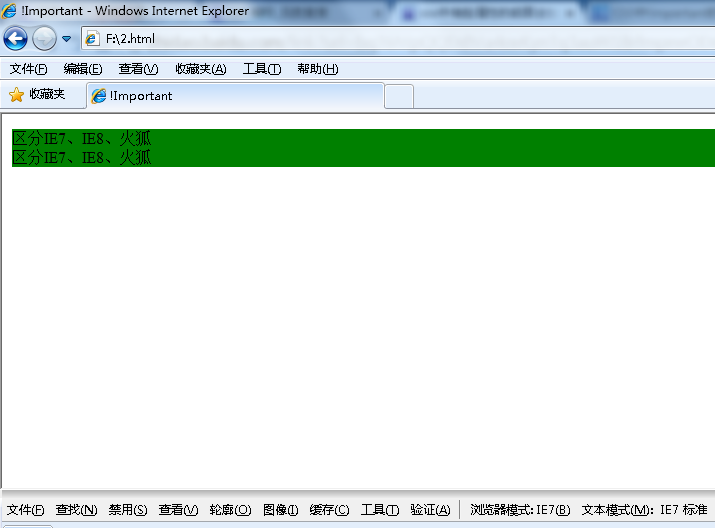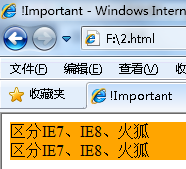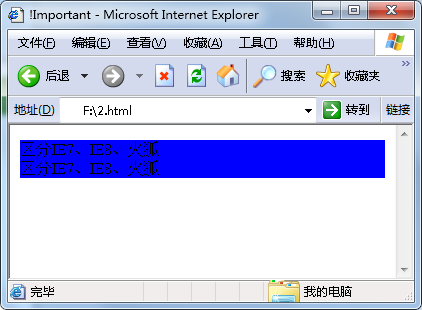详解CSS样式中的!important、*、_符号
详解CSS样式中的!important、*、_符号
!important、*、_其实没什么用,皆是用来设置样式的优先级,但是样式的优先级你可以自行排好其先后位置来设置,然而你还是要看懂的。
我们知道,CSS写在不同的地方有不同的优先级, .css文件中的定义 < 元素style中的属性,但是如果使用!important,事情就会变得不一样。
首先,先看下面一段代码:
1 2 3 4 5 6 7 8 9 10 11 12 | <!DOCTYPE HTML> <html> <head> <meta http-equiv="Content-Type" content="text/html; charset=utf-8"> <title>!Important</title> </head> <body> <div style="color:blue !important;color:red;"> 呵呵 </div> </body> </html> |
“呵呵”两字被定义了两个color,原本在color:red在color:blue之后,这两字应该是红色的,默认取最接近字体的颜色
但是color:blue之后添加了!important,导致color:blue的优先级最高,“呵呵”两字应为蓝色,具体效果如下:
然而,IE6并不能识别style属性中的!important符号,所以导致还是按原来的样式优先级,把“呵呵”两字搞成了红色。
css样式中的!important、*、_符号,皆是用来设置优先级的,但是这些符号,仅在特定的浏览器中适用,具体如下:
IE都能识别*;标准浏览器(如FF)不能识别*;
IE6能识别*,但不能识别 !important;
IE7能识别*,也能识别!important;
FF不能识别*,但能识别!important;
下划线"_", IE6支持下划线,IE7和firefox均不支持下划线。
因此,可以在style属性中定义如下属性,来区分IE6,IE7,firefox:
1 | background:orange;*background:green;_background:blue; |
还可以这样来区分IE6,IE7,firefox:
1 | background:orange;*background:green !important;*background:blue; |
如下的代码:
1 2 3 4 5 6 7 8 9 10 11 12 13 14 15 | <!DOCTYPE HTML> <html> <head> <meta http-equiv="Content-Type" content="text/html; charset=utf-8"> <title>!Important</title> </head> <body> <div style="background:orange;*background:green !important;*background:blue;"> 区分IE7、IE8、火狐 </div> <div style="background:orange;*background:green;_background:blue;"> 区分IE7、IE8、火狐 </div> </body> </html> |
其运行效果如下:
(1)IE7
(2)IE8及其以上的浏览器,含火狐等。
(3)IE6
然而,这样的区别,仅能够自己用于调试,真正的前端编程还是应该利用JavaScript对浏览器的标识判断,来判断这些浏览器的类型。
最后再补充一句,其实IE6仅仅是不能识别style中的!important,如果代码如下所示:
1 2 3 4 5 6 7 8 9 10 11 12 13 14 15 16 17 | <!DOCTYPE HTML> <html> <head> <meta http-equiv="Content-Type" content="text/html; charset=utf-8"> <title>测试Css中的!Important区别</title> <style type="text/css"> .testClass{ color:blue !important; } </style> </head> <body> <div class="testClass" style="color:red;"> 测试Css中的Important </div> </body> </html> |
无论是在ie6-10或者Firefox和Chrome表现都是一致的,都显示蓝色。




